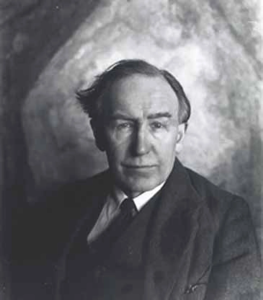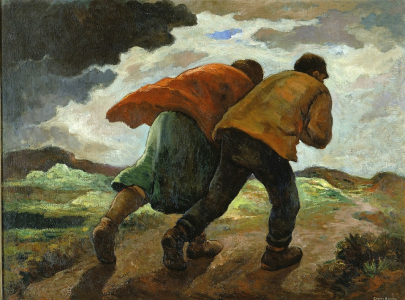
Biography
Eugene Higgins was born in Kansas City, MO in 1874. His father was a stonecutter, and after his mother died in 1878, father and son moved to St. Louis, where they lived in boarding houses. The father was a great admirer of Michelangelo, and while Eugene helped him in the stoneyard, father and son discussed the greatness of the Italian artist. Eugene later recalled that it felt like there were three people living together at the time - he, his father, and Michelangelo.
When Higgins got a little older (age 12 or so), he encountered a magazine with reproductions of the work of Jean-François Millet, whose paintings were to have a profound influence on Higgins. He also read Victor Hugo's Les Miserables, which cemented his views on society's underclass. For a while Higgins even imagined himself as a latter-day Jean Valjean.
Following his public school education, Higgins took night classes at the St. Louis School of Fine Arts. He found the academic regime unsatisfying and went to work in an architect's office. But he had ambitious ideas about painting, and in 1897 he went to Paris to undertake a serious study of art. He studied first at the École des Beaux-Arts under Jean-Léon Gérôme, a painter and sculptor in the French Academic style whose works had been widely reproduced and distributed. Higgins was dismayed to realize that his drawing skills were poor, but he applied himself diligently and ultimately mastered this discipline.
From 1899-1901 Higgins studied at the Académie Julian with Jean-Paul Laurens and Jean-Joseph Benjamin-Constant. Benjamin-Constant was a painter, etcher and writer, who focused on Oriental subjects and portraits. Laurens was a painter and sculptor known for his anti-clerical, republican work, but sometimes criticized as being overly didactic in style. He was one of the last exponents of French Acadmic art.
From his studies in Paris, Higgins learned etching, which became a primary means for him to earn a living. He made a name for himself with his sympathetic portraits of the poor. He himself had little money, and his decision to use street people as his primary subjects may have been in part due to his inability to afford a model. In any case he successfully exhibited his work at the Paris Salon and the American Art Club, and he returned to St. Louis in 1904 with a reputation for portraying the downtrodden. The militant Journal of Social Satire in Art devoted an entire issue to Higgins's "Les Pauvres."
Higgins moved to New York in 1905 and married the artist Mabel Dwight in 1906. She was, like Higgins, a socialist and a painter. But, despite their enlightened views on women, she suppressed her artist career during the 11 years of their marriage. Only after their separation did she blossom as an artist, eventually becoming one of America's leading printmakers. Her work was comparable to that of Higgins, but she had a wittier, less serious touch that may have made her art more accessible than his.
Meanwhile Higgins's career continued to thrive. He showed two paintings and a drawing at the Armory Show in New York in 1913. On the strength of his etching he was elected as an associate of the National Academy of Design in 1921. He participated in exhibitions of the Academy in 1916 and from 1920-1950. His work was also shown at the Pennsylvania Academy of the Fine Arts, the Art Institute of Chicago, the Corcoran Museum in Washington, and various New York galleries.
In the early 1920s Higgins married Anita Rio, a former singer and music teacher. This proved to be a long-lasting union. The couple lived in New York, but from 1924 started spending their summers in Old Lyme, CT. Higgins was elected as a full Academician at the National Academy of Design in 1928. His painting "The Black Cloud" won the Academy's Altman Prize in 1931.
Higgins received commissions for three Post Office murals: "The Armistice Letter" (1938) in Beaver Falls, PA; "The First Settlers" (1939) in Shawano, WI; and "Early Settlers Entering Mt. Pleasant" (1942) in Mount Pleasant, TN.
In 1957 the Library of Congress purchased 240 Higgins etchings. He died in New York, NY in 1958.


Critical Analysis
There is no question about Higgins's dedication to art and his chosen subjects in art. What Millet had done for the peasants of rural France, Higgins sought to do for the urban poor. In particular, he wanted to humanize his subjects, not portray them as merely picturesque. And he succeeded in this effort, as is evident from the massive collection of etchings acquired by the Library of Congress shortly before Higgins's death.
There are two possible criticisms of Higgins's work, which may have affected his commercial reception. First, given his training in Paris, his work was very much in the old school French Academic style. This contrasted with the livelier work of the Ashcan painters, whose popularity eclipsed that of Higgins. Secondly, his single-minded focus on the plight of the down-trodden may have come across as humorless to some, especially if one could have contrasted Higgins's work with that of his first wife, Mabel Dwight.
This said, it's really hard to criticize the honesty and dedication of Higgins's efforts to dramatize the plight of the poor and his hope that by portraying their plight he would stimulate the larger society to make greater efforts to alleviate poverty. Higgins's focus was obviously sincere, and since he himself had grown up in poverty, his artistic ambitions were nourished by his larger ambitions for society.
Murals
- Beaver Falls, Pennsylvania - Post Office: The Armistice Letter
- Mount Pleasant, Tennessee - Post Office: Early Settlers Entering Mt. Pleasant
- Shawano, Wisconsin - Post Office: The First Settlers
References
- David Dearinger, editor, Painting and Sculpture in the Collection of National Academy of Design (v. 1). Hudson Hills , (2004). Brief biographies of Folinsbee (p. 197) and Higgins (p. 271).
- Eugene Higgins (askART).
- Eugene Higgins (Smithsonian American Art Museum).
- Eugene Higgins (Oxford Reference).
- John Spargo, Eugene Higgins: An American Artist Whose Work Upon Canvas Depicts the Derelicts of Civilization as do the Tales of Maxim Gorky in Literature, The Craftsman Volume XII, Number 2, May (1907).
- Robert Bremner, From the Depths: The Discovery of Poverty in the United States. New York University Press , New York, NY (1956). Available at the Internet Archive.
- Introduction (Traditional Fine Arts Organization). Essay by Vincenza Uccello for an exhibition at the Saint Joseph College Gallery, September, 1997.
- Patrick Eugene Higgins (National Academy of Design).